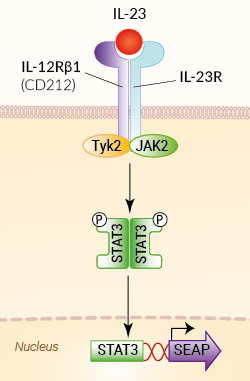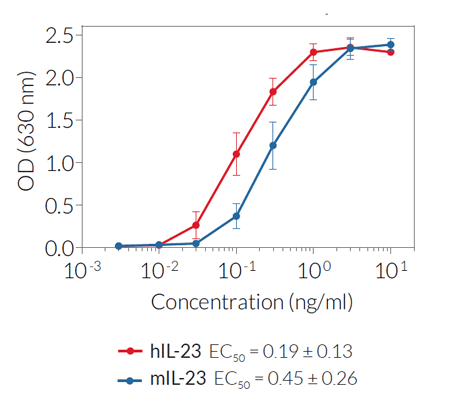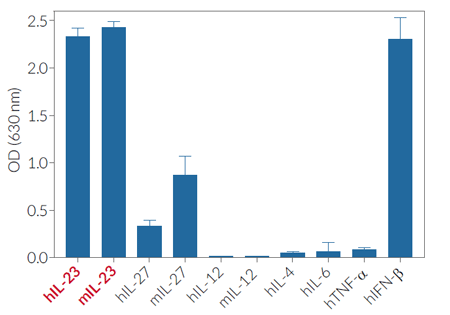IL-23 Reporter HEK 293 Cells
| Product | Unit size | Cat. code | Docs. | Qty. | Price | |
|---|---|---|---|---|---|---|
|
HEK-Blue™ IL-23 Cells Human & Mouse IL-23 Reporter Cells |
Show product |
3-7 x 10e6 cells |
hkb-il23
|
|||
|
HEK-Blue™ IL-23 vial Additional cell vial |
Show product |
3-7 x 10e6 cells |
hkb-il23-av
|
![]() Cytokine offer: For each cytokine reporter cell line purchased, get a free vial of the matching cytokine.
Cytokine offer: For each cytokine reporter cell line purchased, get a free vial of the matching cytokine.
Interleukin-23 Reporter Cells

Signaling pathway in HEK-Blue™ IL-23 cells
InvivoGen also offers:
HEK-Blue™ IL-23 cells were engineered from the human embryonic kidney HEK 293 cell line to detect bioactive human and mouse interleukin-23 (IL-23) by monitoring the activation of the JAK/STAT3 pathway. They can also be used for screening antibodies or small molecule inhibitors targeting the IL-23 pathway.
IL-23 is a key cytokine in the promotion of chronic inflammation and plays a crucial role in the development and maintenance of T helper 17 (Th17) cells [1-3].
Cell line description
HEK-Blue™ IL-23 cells were generated by stable transfection with the genes encoding for the human IL-23 receptor (IL-23R and IL-12Rβ1 chains), as well as STAT3 to obtain a fully functional IL-23 signaling pathway. In addition, they express a STAT3-inducible secreted embryonic alkaline phosphatase (SEAP) reporter. The binding of IL-23 to its receptor triggers a signaling cascade leading to the activation of STAT3 and the subsequent production of SEAP. This can be readily assessed in the supernatant using QUANTI-Blue™ Solution, a SEAP detection reagent.
HEK-Blue™ IL-23 cells detect human (h) and murine (m) IL-23 (see figures). Of note, these cells also respond to h/mIL‑27, another STAT3-signaling cytokine. Furthermore, due to the endogenous expression of the interferon-α/β receptor (IFNAR), these cells respond to hIFN-β (see figures).
Key features
- Fully functional IL-23 signaling pathway
- Readily assessable STAT3-inducible SEAP reporter activity
- Strong response to human (h) and mouse (m) IL-23
Applications
- Detection and quantification of hIL-23 and mIL-23 activity
- Screening of anti-IL-23 and anti-IL-23 receptor antibodies
- Screening of small molecule inhibitors of the IL-23 pathway
References:
1. Teng MW. et al., 2015. IL-23 and IL-23 cytokines: from discovery to targeted therapies for immune-mediated inflammatory diseases. Nat Med. 21(7):719‑29.
2. Vignali DA. & Kuchroo VK., 2012. IL-12 family cytokines: immunological playmakers. Nat Immunol. 13(8):722-8.
3. Duvallet E. et al., 2011. Interleukin-23: a key cytokine in inflammatory diseases. Ann Med. 43(7):503-11.
Specifications
Antibiotic resistance: Blasticidin, Hygromycin B, Zeocin®
Growth medium: DMEM, 4.5 g/l glucose, 2-4 mM L-glutamine, 10% (v/v) fetal bovine serum, 100 U/ml penicillin, 100 μg/ml streptomycin, 100 μg/ml Normocin®
Specificity: Detects human IL-23 and mouse IL-23
Detection range:
- Detection range for human IL-23: 100 pg/ml - 10 ng/ml
- Detection range for murine IL-23: 100 pg/ml - 10 ng/ml
Quality Control:
- SEAP reporter activity in response to IL-23 is validated using functional assays.
- The stability for 20 passages following thawing is confirmed.
- These cells are tested for mycoplasma contamination.
Contents
HEK-Blue™ IL-23 Cells (hkb-il23)
- 1 vial containing 3-7 x 106 cells
- 2 x 1 ml of HEK-Blue Selection (250X concentrate)
- 1 ml of Normocin® (50 mg/ml)
-
1 ml of QB reagent and 1 ml of QB buffer (sufficient to prepare 100 ml of QUANTI-Blue™ Solution, a SEAP detection reagent)
HEK-Blue™ IL-23 vial (hkb-il23-av)
- 1 vial containing 3-7 x 106 cells
![]() Shipped on dry ice (Europe, USA, Canada and some areas in Asia)
Shipped on dry ice (Europe, USA, Canada and some areas in Asia)
Notification: Reference #hkb-il23-av can only be ordered together with reference #hkb-il23.
Back to the topDetails
Interleukin 23 (IL-23), a member of the IL-12 family, is a heterodimeric cytokine composed of the IL-12p40 and IL-23p19 subunits.
IL-23 plays a crucial role in the development and maintenance of T helper 17 cells [1]. It acts by binding to a receptor complex consisting of the IL-12 receptor β1 (IL-12Rβ1) and the IL-23 receptor (IL-23R). Upon binding, IL-23 triggers a signaling pathway involving tyrosine kinase 2 (TyK2) and Janus kinase 2 (JAK2) leading to the activation of signal transducer and activator of transcription 3 (STAT3).
IL-23 has been identified as a central cytokine in autoimmunity and a highly promising treatment target for inflammatory diseases [1-3].
1. Teng MW. et al., 2015. IL-23 and IL-23 cytokines: from discovery to targeted therapies for immune-mediated inflammatory diseases. Nat Med. 21(7):719‑29.
2. Vignali DA. & Kuchroo VK., 2012. IL-12 family cytokines: immunological playmakers. Nat Immunol. 13(8):722-8.
3. Duvallet E. et al., 2011. Interleukin-23: a key cytokine in inflammatory diseases. Ann Med. 43(7):503-11.
Back to the top








